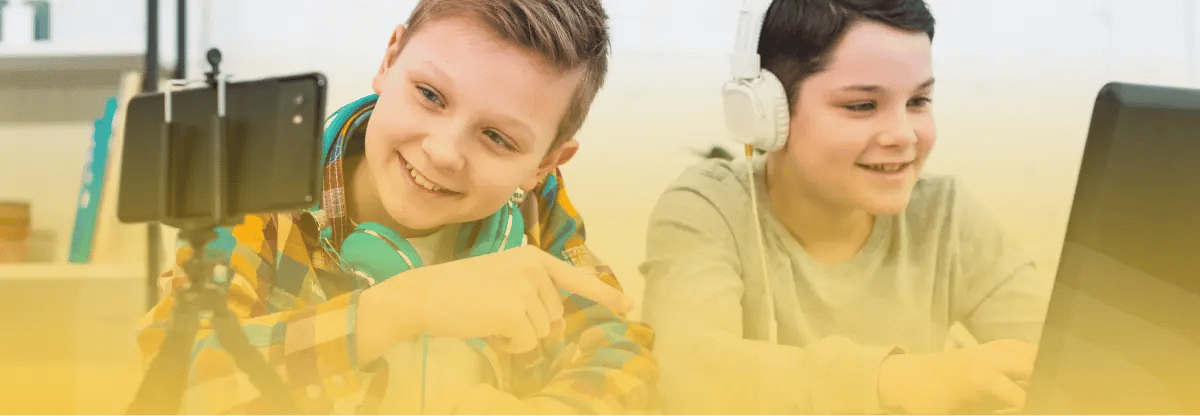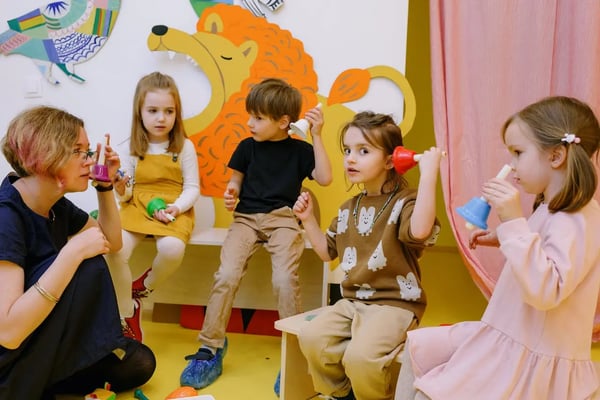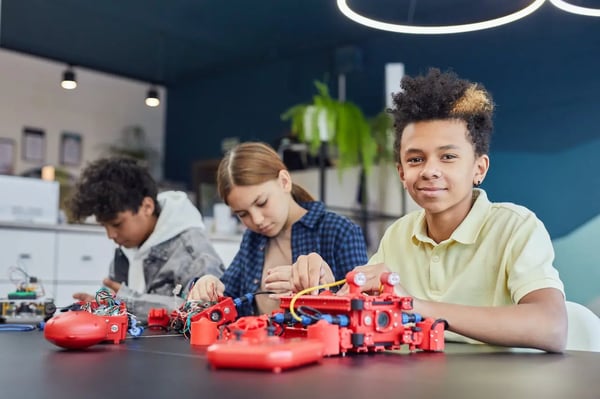
"Engagement" is a popular buzzword floating around the halls of schools and colleges, but what does it really mean? When students are engaged in learning, they do more than answer and ask questions. Instead, they show interest in the subject, feel motivated and curious to learn, and take ownership of their education. Student engagement is not just a "nice to have" skill; it's become essential to student success.
This article reveals student engagement challenges and why it matters in today's classrooms and beyond. We also offer 15 effective engagement strategies and ideas to spark interest and instill deeper learning in students from kindergarten through higher education.
Student engagement challenges
In the quest for engaged students, teachers work tirelessly to create a holistic classroom environment. So why is it still hard to keep students as active learners, especially in today's classrooms? A Gallup survey reveals there's a steady drop in engagement from sixth grade through high school, with only a third of high school students reporting high levels of engagement.
The pandemic also contributed to the decline of student interest. A survey found that only 46 percent of students were engaged in school in 2021, down from 53 percent in 2019.
The most noteworthy reason student engagement is difficult? Learning styles differ from what they used to be.
Traditional rote learning and lectures are no longer the headline in the educational success story. Ed News Daily suggests students often feel their schools take a "one-size-fits-all" teaching approach that doesn't tap into their distinctive skills, interests, or preferences. Today's students are also immersed in multimedia, such as videos, images, and audio. As such, they expect teachers to harness similar methods and activities to make learning more engaging and effective.
.webp?width=600&height=400&name=Image%201%20(1).webp)
Why "leaning in" to engagement matters
Clearly, the struggle of student engagement is real, but why does it matter? In middle and high school, Gallup found that engaged students are 2.5 times more likely to say they are successful in school and are 4.5 times more hopeful about their futures than their peers. One study reveals more than half of the participants said they learn best by doing, and 38 percent said they learn by seeing (videos, multimedia formats).
What about student engagement in higher education? Maryellen Weimer, Ph.D., suggests, "Engagement can be the difference between continuing to degree completion and dropping out. Factors like student-faculty interaction and active and collaborative learning experiences are shown to make a difference."
15 strategies and ideas for effective student engagement
Having effective engagement activities "at the ready" can make all the difference in fostering student success. Below are 15 strategies and ideas for creating a dynamic learning environment from kindergarten to higher education.

1. Whiteboard splash activity
The whiteboard splash activity brings students together and gets them moving.
In action:
First, generate a prompt or question. Have students respond to the prompt and write their answers on the whiteboard, chalkboard, or paper. Next, have students read through what other students have written and make notes of important observations they have yet to consider. What similarities did they find? What differences? And what surprised them?
2. The quote mingle
The quote mingle engagement activity works best as a pre-reading activity.
In action:
- Each student is given a character's line from a book or play and practices reciting the line with inflection.
- Students deliver their lines to at least ten other students.
- Students are then grouped by character and make an inference or prediction based on their character's quotes.
- Groups then recite the character lines to the class and share their inferences.
3. The "says/does" match
The says/does activity offers students an active experience while reviewing specific concepts.
In action:
- Each student is given a printed card with a "quote" or a "does" statement.
- Next, students mingle in the classroom to correctly match their quotes with the "does" statements.
- After students correctly match their "quote" or "does" statement to their counterpart, the partners draft 1-3 sentences embedding the "quote" and "does" statement together.
- Each pair presents their findings to the class.
4. Experiential learning and the "living history" activity
Experiential learning is an engagement strategy that has students develop connections, knowledge, and skills through experiences outside of school.
In action:
Create a "living history" activity for history/social science classes (it can be modified for any subject and grade level.) For instance, if 5th-grade students study Chinese American history at the turn of the 20th century, have students volunteer to help improve a local Chinese garden. Students can then take what they've learned and create group presentations.
.webp?width=600&height=400&name=Image%203%20(1).webp)
5. Video and multimedia learning
Video and multimedia tools are another powerful engagement strategy teachers can use for live-action learning.
In action:
One interactive element is to add pop-up questions (fill-in-the-blank, multiple-choice questions, polls, etc.) throughout your videos. For example, with tools like PlayPosit by WeVideo, you can add interactive features to your lesson or course videos and other elements like YouTube or Vimeo.
6. Bounce cards
With the bounce card participation technique, teachers provide each student with a card that lists key prompts they want them to discuss with a small group.
In action:
For example, if a teacher asks students to discuss a video clip, they might say they "liked it." But using a bounce card forces them to dig deeper. For students who struggle with conversational skills, this can be an excellent tool for helping them develop more thoughtful responses.
7. Students as the teacher
It's amazing to watch a student grasp a concept. Use this moment to ask the student to explain the lesson to the rest of the class.
In action:
Have students demonstrate a lesson previously taught. It can be as simple as mixing the colors blue and red to make purple or as elaborate as a lesson on the principles of kinetic energy.
8. Group work and collaborative multimedia activities
In group work, students come together to investigate and report on a specific subject, topic, or idea.
In action:
For example, if it's a biology class, have students brainstorm the topic of plastic waste in the ocean. What's driving this issue? Are there any solutions to the crisis? Then, have students create a collaborative research video sharing their findings and solutions with the class.
9. Design thinking podcast
Podcasts are not just for adults to listen to their favorite crime drama; they are an excellent tool for engaging students. Podcasting creates an outlet where students can learn how to tell a story or share something they've learned with others.
In action:
Have students gather recyclable objects like cans, cardboard boxes, or similar items. Next, have them create whatever they wish from the recycled material. Finally, have them develop a design thinking podcast explaining each step of the creation process and the finished result.
10. Case studies and the "traffic light" activity
When using a case study, students review a real-life situation and explore how they would resolve it. Here's a twist on the original called the traffic light exercise.
In action:
Have students read a case study and write a short essay answering one of three study questions you create about the readings. The next day, have students assemble in groups and explain the traffic light activity.
- Give students three cards: red, yellow, and green. Have students write their names on all three.
- A red card means they want to refrain from participating.
- A yellow card means they're willing to participate but do not want questioning by the instructor.
- A green card means they welcome in-depth questioning by the instructor.
Points accompany each color choice: two points for green cards, one point for yellow, and no points for red. The points system can be modified for any grade level. Begin class with a quote from one of the student's essays and ask the student to elaborate on it. Then, ask other students to join the discussion. They can use this time to select one of the three cards.

11. Interactive video and discussion boards
Interactive videos can be created for any grade level. However, in higher education, video lessons allow students to analyze, understand, and apply concepts in synchronous and asynchronous environments.
In action:
Interactive video instruction allows professors to measure and maintain engagement in real-time with embedded questions like multiple-choice, free-response, and polls. Use videos to build threaded discussion boards to foster more robust collaboration and communication, even in asynchronous environments.
12. The 1, 5, and 15-minute activity
College faculty use the 1, 5, and 15-minute activities to offset bland classroom presentations.
In action:
Professors have students present every week in one of three formats: 1 minute (seven students per week), 5 minutes (three to four students), or 15 minutes (two students).
- One minute: students present an idea that illustrates the week's topic. Questions follow.
- Five minutes: students present a more detailed perspective on the topic. Questions follow.
- Fifteen minutes: the student provides a copy of the paper for the class a week before the presentation. Every student posts open-ended questions about the paper on the website at least 48 hours before the class meets. The student presenter addresses these questions in the presentation.
13. 3-sentence wrap-up
This activity serves as a gauge of student understanding.
In action:
- Pose a question anytime during a lesson.
- Ask students to write a response in three sentences.
- Answers are collected anonymously and reviewed by the teacher.
14. The flipped classroom debate
Having a debate is a great way to introduce the flipped classroom technique. This engagement strategy allows students to have the new material before class, freeing class time for advanced thinking and activities.
In action:
Choose a controversial topic and determine which side of the argument the students would support. Have students review material on the topic the night before class.
- Once in class, separate the students into groups based on their alignment.
- Give students 30 minutes to prepare an argument, and then have each group pair up with a group of opposing viewpoints and engage in a debate.
- Synthesize the different points of debate in a larger class discussion.
15. Concept maps
A concept map is a visible presentation that helps students see relationships between ideas, concepts, or authors and clarifies ideas.
In action:
Explain to students that they will create a concept map for your chosen topic. Let's use a story's " hero journey " as an example.
- First, ask students to list words, phrases, and ideas about the story's hero or protagonist.
- Next, have students write a topic or question surrounding the "hero journey" in the center of a piece of paper. Ask students to sort the ideas and organize their list on the page in a way that makes sense to them. For example, students might use color to help sort their lists into categories.
- After students sort their lists, ask them to connect similar ideas with lines, dotted lines, and arrows. In small groups, ask students to share their maps.
Final thoughts
Student engagement is a critical aspect of education, requiring a holistic approach. By building connections, creating room for creativity, and embracing challenges, educators can foster an environment where students are actively involved and motivated to excel. But most of all, it's about enjoying the journey and getting students excited to learn!
See how video transforms student engagement
.jpg)